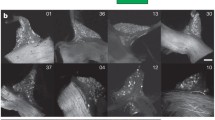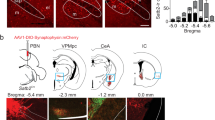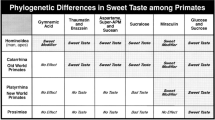Summary
The receptive field (RF) of 67 taste and 85 mechanoreceptive neurons in the solitary tract nucleus (NTS) were located in the oral cavity in albino rats. All of the taste and most (62.4%) of the mechanoreceptive neurons examined had an RF on the ipsilateral side of the tongue and/or the palate. Regardless of whether they were solitario-parabrachial relay (SP) neurons or non-SP neurons, RFs of taste neurons were found on the anterior as well as the posterior tongue. But there were some differences in the RF distribution between the SP and non-SP mechanoreceptive neurons. Most of the mechanoreceptive SP neurons (9 of 11) had an RF on the tongue, while ca. half of the mechanoreceptive non-SP neurons (43 of 79) had an RF on the tongue and palate, but the rest had an RF on other tissue. Most of the neurons studied had a small restricted RF, but complex RFs, e.g. two separate RFs on the tongue, were found in a relatively small number of neurons (four taste and five mechanoreceptive neurons). An inhibitory RF, usually in a remote place from the excitatory RFs, was found in four mechanoreceptive neurons but no inhibitory RFs for taste neurons. Electrical stimulation of the epithelium in the RF with a low current of short duration evoked a few spikes in most units. Two of the three units, giving rise to a vigorous response to taste stimulation, but having single restricted RFs on the anterior tongue, produced a train of spikes lasting more than 20 ms in response to electrical stimulation of the RF. Neurons with RFs on the anterior tongue and those with RFs on the posterior tongue were located in different regions in the NTS, suggesting a possible somatotopic representation of the oral cavity in the nucleus. RFs of neither taste neurons nor mechanoreceptive neurons could be found in the tongue region containing the circumvallate papilla. The possible reasons are discussed.
Similar content being viewed by others
References
Biedenbach MA, Chan KY (1971) Tongue mechanoreceptors: Comparisons of afferent fibres in the lingual nerve and chorda tympani. Brain Res 35: 584–588
Blomquist AJ, Antem A (1965) Localization of the terminals of the tongue afferents in the nucleus of the solitary tract. J Comp Neurol 124: 127–130
Doetsch GS, Erickson RP (1970) Synaptic processing of taste-quality information in the nucleus tractus solitarius of the rat. J Neurophysiol 33: 490–507
Ganchrow JR, Erickson RP (1970) Neural correlates of gustatory intensity and quality. J Neurophysiol 33: 768–783
Halpern BP, Nelson LM (1965) Bulbar gustatory responses to anterior and to posterior tongue stimulation in the rat. Am J Physiol 209: 105–110
Kasahara Y, Kawamura Y (1976) Mechanosensitive afferent fibers in the chorda tympani. J Physiol Soc Jpn 37: 286
Makous W, Nord S, Oakley B, Pfaffmann C (1963) The gustatory relay in the medulla. In: Zotterman Y (ed) Olfaction and taste. Pergaman, London, pp 381–393
Miller IJ Jr (1971) Peripheral interactions among single papilla inputs to gustatory nerve fibers. J Gen Physiol 57: 1–25
Miller IJ Jr (1976) Taste bud distribution and regional responsiveness on the anterior tongue of the rat. Physiol Behav 16: 439–444
Miller IJ Jr (1977) Gustatory receptors of the palate. In: Katsuki Y, Sato M, Takagi S, Oomura Y (eds) Food intake and chemical senses. Univ. of Tokyo, Tokyo, pp 173–185
Ogawa H, Hayama T (1981) Receptive fields of neurons in the rostral part of the nucleus tractus solitarius in rats. Neurosci Lett (Suppl) 6: 102
Ogawa H, Hayama T, Ito S (1982) Convergence of input from tongue and palate to the parabrachial nucleus neurons of rats. Neurosci Lett 28: 9–14
Ogawa H, Imoto T, Hayama T (1984) Responsiveness of solitario-parabrachial relay neurons to taste and mechanical stimulations applied to the oral cavity in rats. (Accompanying paper)
Ogawa H, Kaisaku J (1982) Physiological characteristics of the solitario-parabrachial relay neurons with tongue afferent inputs in rats. Exp Brain Res 48: 362–368
Ogawa H, Kaisaku J, Noma A, Sato M (1980) Presynaptic inhibition produced by tongue nerves in the rostral part of the nucleus tractus solitarii. In: Ito M, Tsukahara N, Kubota K, Yagi K (eds) Integrative control functions of the brain. Kohdansha Scientific, Tokyo, pp 89–90
Ogawa H, Sato M, Yamashita S (1968) Multiple sensitivity of chorda tympani fibers of the rat and hamster to gustatory and thermal stimuli. J Physiol (Lond) 199: 223–240
Pfaffmann C (1970) Physiological and behavioral processes of the sense of taste. In: Wolstenholme GEW, Knight J (eds) Taste and smell in vertebrates. Churchill, London, pp 31–45
Sweazey RD, Dickman JD, Smith DV (1981) Converging taste receptor inputs to the hamster solitary tract nucleus. Neurosci Abst 7: 665
Torvik A (1956) Afferent connections to the sensory trigeminal nuclei, the nucleus of the solitary tract and adjacent structures. An experimental study of the rat. J Comp Neurol 106: 51–141
Woolston DC, Erickson RP (1979) Concept of neuron types in gustation in the rat. J Neurophysiol 42: 1390–1409
Author information
Authors and Affiliations
Additional information
Supported by a Grant from the Ministry of Education, Science and Culture of Japan (No. 58106008)
Rights and permissions
About this article
Cite this article
Ogawa, H., Hayama, T. Receptive fields of solitario-parabrachial relay neurons responsive to natural stimulation of the oral cavity in rats. Exp Brain Res 54, 359–366 (1984). https://doi.org/10.1007/BF00236237
Received:
Issue Date:
DOI: https://doi.org/10.1007/BF00236237




